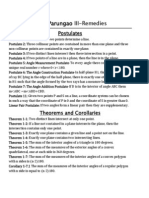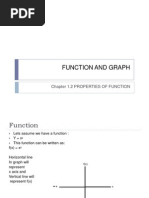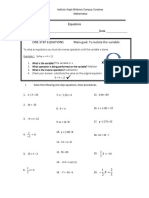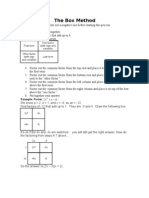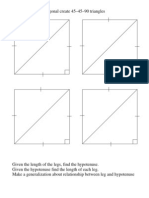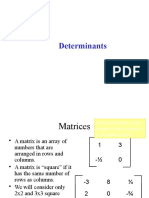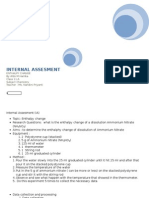Math Internal Assessment
Math Internal Assessment
Uploaded by
Aldo HamkaCopyright:
Available Formats
Math Internal Assessment
Math Internal Assessment
Uploaded by
Aldo HamkaOriginal Description:
Copyright
Available Formats
Share this document
Did you find this document useful?
Is this content inappropriate?
Copyright:
Available Formats
Math Internal Assessment
Math Internal Assessment
Uploaded by
Aldo HamkaCopyright:
Available Formats
Math Internal Assessment
G-force Tolerance
Byeolah Henson
The G-Force is the result of the acceleration and the gravity. It is the force that is
caused by the gravity when one goes through certain acceleration. G-force es!ecially the
hori"ontal g-force can be a!!lied to everyday life. But the most common way to e#!erience
both hori"ontal and vertical g-force is the rollercoaster. $hen a rollercoaster is going in a fast
and hori"ontal acceleration one%s body tends to get !ushed bac&wards due to g-force. This is
often &nown as 'eye balls-in(. )n the other hand 'eye balls- out( is when the rollercoaster
moves bac&ward one%s body tend get !ushed forward. The o!!osite movement of the body
and acceleration also a!!lies to vertical g-force. For e#am!le when the rollercoaster shoots
u! one e#!erience 'blood towards feet(.
G-force is label with g. For e#am!le * re!resent the five times the force of the
gravity.
This data shows the a forward acceleration G# +g, where one e#!eriences the 'eye
balls- in( and the time that a human being can e#!erience
Time +min, -G# +g,
../ 0*
...0 12
../ 1.
..0 /*
/ //
0 3
/. 4
0. 5.*
In this data hori"ontal G-force the human beings toleration time is de!endent on the
!ositive acceleration that one is e#!eriencing in. By means the time will vary from the
change for the acceleration. Hence the forward acceleration in the hori"ontal direction is the
inde!endent variable or the 6 and the Time +min, is the de!endent variable the 7. The
!arameter of this data that any !ositive variables. However the limitation or constraints of
this data is that time cannot be negative which means that the de!endent variables cannot be
negative. Hence the hori"ontal asym!totes can be !redicted on .. Also since this only
e#!lains the !ositive acceleration there cannot be any negative numbers for 6 the
inde!endent variable.
6 +inde!endent, 7 +de!endent,
0* .../
12 ...0
1. ../
/* ..0
// /
3 0
4 /.
5.* 0.
According to the gra!h shown above the time of one can e#!erience reduces as the
acceleration increases. This decrease is ra!id in the beginning but as it a!!roaches near . it
slows down with a curve. All of the variables of the data are only !resent on the first
8uadrant. Also as e#!ected the hori"ontal asym!tote at . is very visible in this gra!h.
Thus the e#!onential function model
x
ab y = seems to be a!!ro!riate for this gra!h.
A lot li&e this gra!h the e#!onential functions have ra!id decrease in the beginning and a
curve near the a#is. Also in the e#!onential function y cannot be . or negative. 9esulting the
e#!onential model to have a hori"ontal asym!tote at . li&e the gra!h.
To create an e8uation using the e#!onential function model !ic& two !oints of the
data.
, / // + , 0. * . 5 +
These two !oints seems to be most reasonable use in order to fit the starting !oint of
the ra!id decrease or the highest !oint and the other one reveals the end of the curve.
In order to solve for a and b, !lug these coordinates into the formula
x
ab x y = , + .
//
/ ab =
* . 5
0. ab =
By using the second e8uation
* . 5
0. ab =
solve for a.
* . 5
0. ab =
:ivide both sides with b
5.*
a
b
=
* . 5
0.
In order to solve for b substitute
a
b
=
* . 5
0.
to
//
/ ab =
//
* . 5
0.
/ b
b
=
;im!lify.
* . 4
0. / b =
:ivide both sides with 0.
* . 4
0.
/
b =
b =
* . 4
0.
/
*30 . . = b
To solve for
a
substitute
*30 . . = b to a
b
=
* . 5
0.
.
* . 5
*30 . .
0.
= a
0/* = a
<lug the a and b to the function.
( )
x
x y *30 . . 0/* , + =
The red line re!resents the model function
( )
x
y *30 . . 0/* =
and the green dots re!resent the
original data.
The e#!onential function seems to fit fairly right with the original data. Most of the
!oints of the original gra!h are included in the model. ;o there is going to be no revision of
the function.
The model of the e#!onential function shows the decrease of time with the increase of
!ositive acceleration. It shows that the less acceleration results higher toleration time.
The e#!onential regression line is in !ur!le e#!onential function is shown in red and the
green dots re!resents the original data.
=#!onential regression line is used to show the best fitting model using technology.
Although regression line shows the similar trend with the original data with the e8uation of
x
x y , >>3 . . + 5 . 0. , + = it does not su!!ort the original data as much as the e#!onential
function. First of all fewer !oints are included in the regression line than the e#!onential
function. But more im!ortantly the regression line e#ceeds through . for # unli&e the
e#!onential function.
This table show the u!ward or !ositive vertical acceleration -G"+g, and the time a
human being can tolerate revealing the vertical g-force and 'blood towars feet(.
Time +min, -G"+g,
.../ /2
...0 /5
../ //
..0 3
/ >
0 4
/. 5.*
0. 0.*
?i&e it was done !reviously rearrange the table showing the inde!endent +#, and de!endent
+y, variables.
6 +inde!endent, 7 +de!endent,
/2 .../
/5 ...0
// ../
3 ..0
> /
4 0
5.* /.
0.* 0.
The red line re!resents the e#!onential function and the brown dots re!resent the new data.
The first model which is the e#!onential function does not fit well on this new data
as it did on the original data. This new data is shifted more to the left than the original one.
A vertical stretch a hori"ontal stretch and shifts are needed.
@ , *30 +. 0/* A 1 , +
, / 1 +
=
x
x y
The revised e#!onential function is shown in green the original function model is
shown in red and the red dots re!resent the new data.
$hether it is a vertical acceleration or hori"ontal acceleration there cannot be a
negative in time. Also in both vertical and hori"ontal g-force there the time toleration
decreases as the acceleration increases. This means that for human beings the faster the
movement or the acceleration is the less time one will e#!erience. Although there is a limit or
an asym!tote on . on time to some !oint with too much of acceleration one can come to the
!oint where the g-force endangers one%s life.
You might also like
- Jacaranda Maths Quest 12 Specialist Mathematics VCE Units 3 4 Second Edition Jacaranda 2024 Scribd DownloadDocument40 pagesJacaranda Maths Quest 12 Specialist Mathematics VCE Units 3 4 Second Edition Jacaranda 2024 Scribd Downloadngorohoiyu100% (4)
- Math AA HL IA 2023Document19 pagesMath AA HL IA 2023eshaan aroraNo ratings yet
- SAT Number PropertiesDocument6 pagesSAT Number PropertiesΜάριος Α. ΠαππάςNo ratings yet
- GE752 DC MotorDocument82 pagesGE752 DC MotorAhmed Shawky100% (6)
- Postulates, Defs, and TheoremsDocument4 pagesPostulates, Defs, and TheoremsacciofabNo ratings yet
- Wilts & Dorset Bus Company TimetableDocument4 pagesWilts & Dorset Bus Company TimetableJim KettleNo ratings yet
- 1 Given The History of Large Cost Overruns Associated WithDocument1 page1 Given The History of Large Cost Overruns Associated WithAmit PandeyNo ratings yet
- Add Maths Practice Paper 1Document16 pagesAdd Maths Practice Paper 1tawiahgerald23No ratings yet
- Warm Up Lesson Presentation Lesson Quiz: Holt Mcdougal Algebra 2 Holt Algebra 2 Holt Mcdougal Algebra 2Document27 pagesWarm Up Lesson Presentation Lesson Quiz: Holt Mcdougal Algebra 2 Holt Algebra 2 Holt Mcdougal Algebra 2Rica MelchorNo ratings yet
- Spaghetti Sine Curve ActivityDocument2 pagesSpaghetti Sine Curve Activitygirisha123No ratings yet
- Asymptote Horizontal Asymptote: Horizontal Asymptotes Are Horizontal Lines To Which The Function IsDocument19 pagesAsymptote Horizontal Asymptote: Horizontal Asymptotes Are Horizontal Lines To Which The Function IsMohd Hazwan ZulkifliNo ratings yet
- Algebraic ExpressionsDocument24 pagesAlgebraic Expressionsmanahilnasir67No ratings yet
- Geometric Sequences PDocument11 pagesGeometric Sequences PIr HeriawanNo ratings yet
- The Golden Ratio What Is The Golden Ratio?: A B C F E DDocument10 pagesThe Golden Ratio What Is The Golden Ratio?: A B C F E DFayeSmith55100% (1)
- T3-8.3 Trig Intro SohcahtoaDocument2 pagesT3-8.3 Trig Intro SohcahtoaCharlie WilliamsonNo ratings yet
- Functions of Several VariablesDocument26 pagesFunctions of Several VariablesIanNo ratings yet
- Function and Graph: Chapter 1.2 Properties of FunctionDocument22 pagesFunction and Graph: Chapter 1.2 Properties of FunctionSajalAhmed100% (1)
- ML Geometry 6-1 PolygonsDocument7 pagesML Geometry 6-1 Polygonsmadhuraju778797No ratings yet
- 2.5 Reasoning in Algebra and Geometry Practice Worksheet Form GDocument2 pages2.5 Reasoning in Algebra and Geometry Practice Worksheet Form GDenney DongNo ratings yet
- Indeterminate Forms and LHopitals Rule Presentation SlidesDocument45 pagesIndeterminate Forms and LHopitals Rule Presentation SlidesS.m. ChandrashekarNo ratings yet
- Introduction To LogarithmsDocument12 pagesIntroduction To LogarithmsGena Clarish CarreonNo ratings yet
- Rearranging The FormulaeDocument14 pagesRearranging The FormulaeKhin Myat MawNo ratings yet
- For DemoDocument18 pagesFor DemoNecie Letran SalazarNo ratings yet
- Madasmaths Hard Question PaperDocument6 pagesMadasmaths Hard Question PaperMadalina Novac100% (1)
- 1GP Week 5 Math 7Document20 pages1GP Week 5 Math 7Raymond De VeraNo ratings yet
- Addition and Subtraction of Functions FINALDocument27 pagesAddition and Subtraction of Functions FINALSue ZanneNo ratings yet
- 3.3 Function NotationDocument13 pages3.3 Function NotationEzekiel ArenzNo ratings yet
- Integration DI Mathematical Studies - 2014Document18 pagesIntegration DI Mathematical Studies - 2014A ANo ratings yet
- l-22 Introduction To TrigonometryDocument3 pagesl-22 Introduction To Trigonometrysoorya_taNo ratings yet
- Trigonometry Flowchart 3Document10 pagesTrigonometry Flowchart 3Harshavardhan A100% (1)
- Ch. 4. Determinants WorksheetDocument3 pagesCh. 4. Determinants WorksheetBiju Thomas HPS RNo ratings yet
- Chinese PostmanDocument21 pagesChinese Postmandharmapriyauss33% (3)
- Quadratic Inequalities: Jocelyn D. IsipDocument17 pagesQuadratic Inequalities: Jocelyn D. IsipIsrael MarquezNo ratings yet
- Statistics 1 AQA Revision NotesDocument7 pagesStatistics 1 AQA Revision NotesShiv Kumar SinghNo ratings yet
- Em 18 Equilibrium of A ParticleDocument2 pagesEm 18 Equilibrium of A ParticleFattihi EkhmalNo ratings yet
- Quadratic EquationDocument1 pageQuadratic EquationEmyRaNo ratings yet
- One and Two Step EquationsDocument2 pagesOne and Two Step EquationsMich Castilleja100% (2)
- Integers Final Assessment TextDocument13 pagesIntegers Final Assessment Textpearl015No ratings yet
- Assessment 28 of 100 Rational Functions - HL - AA and AI Old Math HL - From Prof IyerDocument11 pagesAssessment 28 of 100 Rational Functions - HL - AA and AI Old Math HL - From Prof IyersriramaniyerNo ratings yet
- Topic 15: Vectors II (Lines and Planes) : Key Questions To AnswerDocument4 pagesTopic 15: Vectors II (Lines and Planes) : Key Questions To AnswergreenlinkNo ratings yet
- Basic Properties of IntegersDocument7 pagesBasic Properties of IntegersTom DavisNo ratings yet
- Factoring-Box MethodDocument1 pageFactoring-Box Methodmishi19No ratings yet
- Paper Plate Intro Unit CircleDocument9 pagesPaper Plate Intro Unit CirclecatheagenNo ratings yet
- Arithmetic Mean ( ) : Jude Michelle J. Ureta Mpa IiDocument7 pagesArithmetic Mean ( ) : Jude Michelle J. Ureta Mpa IiSam GNo ratings yet
- Math AA SL P 1 Marks SchemeDocument6 pagesMath AA SL P 1 Marks SchemeMrin GhoshNo ratings yet
- PP - Sequences - and - Sums - Markscheme - Ib Maths AA SLDocument19 pagesPP - Sequences - and - Sums - Markscheme - Ib Maths AA SLEmNo ratings yet
- DeterminantsDocument21 pagesDeterminantsShivani NainNo ratings yet
- Quadratic Functions in Standard FormDocument12 pagesQuadratic Functions in Standard FormLucyNMNo ratings yet
- Edited - 6Document5 pagesEdited - 6api-534894553No ratings yet
- Functions and GraphsDocument23 pagesFunctions and GraphsCancan ManlutacNo ratings yet
- Chapter 5 INTRODUCTION TO TRIGONOMETRYDocument5 pagesChapter 5 INTRODUCTION TO TRIGONOMETRYLiyakath AliNo ratings yet
- Implicit DifferentiationDocument8 pagesImplicit Differentiationjake8837No ratings yet
- IGCSE (9-1) Maths - Practice Paper 4HDocument27 pagesIGCSE (9-1) Maths - Practice Paper 4HNooreldeenNo ratings yet
- FSMA Fractions Decimals Percentages StudentDocument17 pagesFSMA Fractions Decimals Percentages StudentAsis Sahoo100% (1)
- 12 - CongruencesDocument5 pages12 - CongruencesJUNALYN MANATADNo ratings yet
- Buy ebook Barron's AP Calculus Flash Cards. Covers Calculus AB and BC topics cheap priceDocument24 pagesBuy ebook Barron's AP Calculus Flash Cards. Covers Calculus AB and BC topics cheap priceqomahbunag100% (2)
- Coterminal AnglesDocument19 pagesCoterminal AnglesfafafaNo ratings yet
- Progressions A.P, G.PDocument13 pagesProgressions A.P, G.PAnanth SureshNo ratings yet
- CC CCCCC: LCD Projector Powerpoint Graphing Calculators Work Sheet ArticleDocument3 pagesCC CCCCC: LCD Projector Powerpoint Graphing Calculators Work Sheet ArticleHLSSummerInstituteNo ratings yet
- Using Spreadsheets For Projectile MotionDocument5 pagesUsing Spreadsheets For Projectile MotionshimonmakNo ratings yet
- (Lecture 1) Translational MotionDocument16 pages(Lecture 1) Translational MotiondropgorgeousNo ratings yet
- Hooke's Law LabDocument4 pagesHooke's Law Labhafiz_yusoff1620No ratings yet
- CPR Training Via Public Kiosks Could Save LivesDocument2 pagesCPR Training Via Public Kiosks Could Save LivesAldo HamkaNo ratings yet
- Memory Interference (Repaired) (Repaired)Document10 pagesMemory Interference (Repaired) (Repaired)Aldo HamkaNo ratings yet
- RaulDocument1 pageRaulAldo HamkaNo ratings yet
- IA Chemistry 2 Rate of ReactionDocument2 pagesIA Chemistry 2 Rate of ReactionAldo Hamka0% (1)
- How Was The Universe FormDocument1 pageHow Was The Universe FormAldo HamkaNo ratings yet
- IA Chemistry 1 Enthalpy ChangesDocument6 pagesIA Chemistry 1 Enthalpy ChangesAldo HamkaNo ratings yet
- Ia Psychology AldoDocument17 pagesIa Psychology AldoAldo HamkaNo ratings yet
- General Knowledge About DreamDocument2 pagesGeneral Knowledge About DreamAldo HamkaNo ratings yet
- Design Experiment: Aim: To See That The Different Kind of State ofDocument3 pagesDesign Experiment: Aim: To See That The Different Kind of State ofAldo HamkaNo ratings yet
- Acara Ghatering LK 7 NovemberDocument5 pagesAcara Ghatering LK 7 NovemberAldo HamkaNo ratings yet
- Group 2 Ms Ardan Ahmad Tohari Sapardi Joko Dmono Group 3 Muctar Lubis Abdul Muis Leo TolstoyDocument1 pageGroup 2 Ms Ardan Ahmad Tohari Sapardi Joko Dmono Group 3 Muctar Lubis Abdul Muis Leo TolstoyAldo HamkaNo ratings yet
- Appendices: Standardized BriefingDocument9 pagesAppendices: Standardized BriefingAldo HamkaNo ratings yet
- Name of Enzymes +source+substrate+product Function of Every Part in Digesive System Different Between Absortion and AssimilationDocument1 pageName of Enzymes +source+substrate+product Function of Every Part in Digesive System Different Between Absortion and AssimilationAldo HamkaNo ratings yet
- How Heaven Is Made ? Demon Blood of CourseDocument1 pageHow Heaven Is Made ? Demon Blood of CourseAldo HamkaNo ratings yet
- People Should Realize That The World Is Not UnlimitedDocument1 pagePeople Should Realize That The World Is Not UnlimitedAldo HamkaNo ratings yet
- How The Hell Is MadeDocument1 pageHow The Hell Is MadeAldo HamkaNo ratings yet
- LAZZATI BrochureDocument140 pagesLAZZATI BrochureLazzati - High Performance Boring MillsNo ratings yet
- Quizlet PDFDocument12 pagesQuizlet PDFHatake KakashiNo ratings yet
- Assinment 1 Week 4Document39 pagesAssinment 1 Week 4sharonwairimu600No ratings yet
- SQL Queries ExcersciseDocument15 pagesSQL Queries ExcersciseVijay Kanth VJNo ratings yet
- Afm Unit 1 - 5Document83 pagesAfm Unit 1 - 5Munni ChukkaNo ratings yet
- Sa EditedDocument29 pagesSa EditedDevil KenwayNo ratings yet
- CMAX Operation Manual of SC Building Hoist 2015Document106 pagesCMAX Operation Manual of SC Building Hoist 2015Jameela Perez100% (2)
- Alert Operators Transmission - Aot: Customer Services DirectorateDocument4 pagesAlert Operators Transmission - Aot: Customer Services DirectorateIbrahim KhalilNo ratings yet
- H V S C Report On Irregularities of Trust and Societies of Chautala - Naresh KadyanDocument3 pagesH V S C Report On Irregularities of Trust and Societies of Chautala - Naresh KadyanAbhishek KadyanNo ratings yet
- Pex4 User ManualDocument95 pagesPex4 User ManualDam Ngoc KienNo ratings yet
- WBHS Opd App Form EmpDocument3 pagesWBHS Opd App Form EmprajaimportantdocumentsNo ratings yet
- ABC of Fire Alarm SystemsDocument2 pagesABC of Fire Alarm SystemsYuvraj Kumar100% (1)
- Handbook of Research Methods in Social and Personality Psychology 2nd Edition Harry Reis all chapter instant downloadDocument67 pagesHandbook of Research Methods in Social and Personality Psychology 2nd Edition Harry Reis all chapter instant downloaderxanjawhraNo ratings yet
- Muet Writing Pass YearDocument3 pagesMuet Writing Pass YearSepth Bay Jia EnNo ratings yet
- 2006 National Standard Plumbing Code ILLUSTRATED 255 PDFDocument1 page2006 National Standard Plumbing Code ILLUSTRATED 255 PDFAhmed Mohamed GadoNo ratings yet
- Ncsimul Solutions Optitool enDocument4 pagesNcsimul Solutions Optitool enluli pejaNo ratings yet
- Starbucks Case Study - Docx For PresentationDocument1 pageStarbucks Case Study - Docx For PresentationChieMae Benson QuintoNo ratings yet
- Model of Automatic Bottle Filling and Capping Mechanism: Logistics and Supply Chain ManagementDocument17 pagesModel of Automatic Bottle Filling and Capping Mechanism: Logistics and Supply Chain ManagementNguyễn Quỳnh100% (1)
- TLA - CO2 - Pfizer - Pharmaceutical Marketing and EntrepreneurshipDocument2 pagesTLA - CO2 - Pfizer - Pharmaceutical Marketing and EntrepreneurshipRizalyn Joy CristobalNo ratings yet
- Protocol CryogenicsDocument2 pagesProtocol CryogenicsHatimNo ratings yet
- Capstone-Interim Hero Honda Break-UpDocument23 pagesCapstone-Interim Hero Honda Break-UpAshwini KJNo ratings yet
- Experiment 1 Schematic Drawing and PCB Design: ObjectiveDocument5 pagesExperiment 1 Schematic Drawing and PCB Design: ObjectiveGuadalajara JaliscoNo ratings yet
- Demand NoticeDocument2 pagesDemand Noticeraja.hamzafarooq786No ratings yet
- LG-8X3200-Hydraulic Brake Shearing MachineDocument8 pagesLG-8X3200-Hydraulic Brake Shearing MachineFahadNo ratings yet
- Maini Groups Aerospace VentureDocument4 pagesMaini Groups Aerospace Venturebillatony100% (1)
- Mrs. Ramanjooloo Vanisha ... : Negative Dark YellowDocument2 pagesMrs. Ramanjooloo Vanisha ... : Negative Dark Yellowkhirthana16ramanjoolooNo ratings yet
- CP2403 - Practical 7 - INTDocument7 pagesCP2403 - Practical 7 - INTnangayebokhamNo ratings yet




